43.5: 人类怀孕和分娩
- Page ID
- 202604
培养技能
- 解释妊娠三个月的胎儿发育情况
- 描述人工和分娩
- 比较各种避孕药具的疗效和持续时间
- 讨论不育的原因和可用的治疗方案
怀孕从卵子的受精开始,一直持续到个体出生。 不同动物的妊娠时间各不相同,但大猩猩的妊娠时间非常相似:人类妊娠266天,黑猩猩的妊娠期为237天,大猩猩的妊娠期为257天,猩猩的妊娠期为260天。 狐狸的妊娠期为57天。 狗和猫的平均妊娠天数相似,平均为60天。 陆地哺乳动物的妊娠时间最长为640天。 海洋哺乳动物中妊娠时间最长的是白鲸和抹香鲸,长达460天。
人类妊娠
受精前二十四小时,卵子已完成减数分裂,成为成熟的卵母细胞。 受精后(受孕时),卵子被称为合子。 合子穿过输卵管到达子宫(图\(\PageIndex{1}\))。 发育中的胚胎必须在七天内植入子宫壁,否则会变质并死亡。 合子(囊泡)的外层通过消化子宫内膜细胞长成子宫内膜,子宫内膜的伤口愈合将囊胚封闭到组织中。 囊胚的另一层绒毛膜开始释放一种叫做人类 β 绒毛膜促性腺激素(β-HCG)的激素,它会进入黄体并保持该结构的活性。 这样可以确保足够的孕酮水平,从而维持子宫的子宫内膜,为发育中的胚胎提供支持。 妊娠试验确定尿液或血清中 β-HCG 的水平。 如果存在激素,则检测结果为阳性。
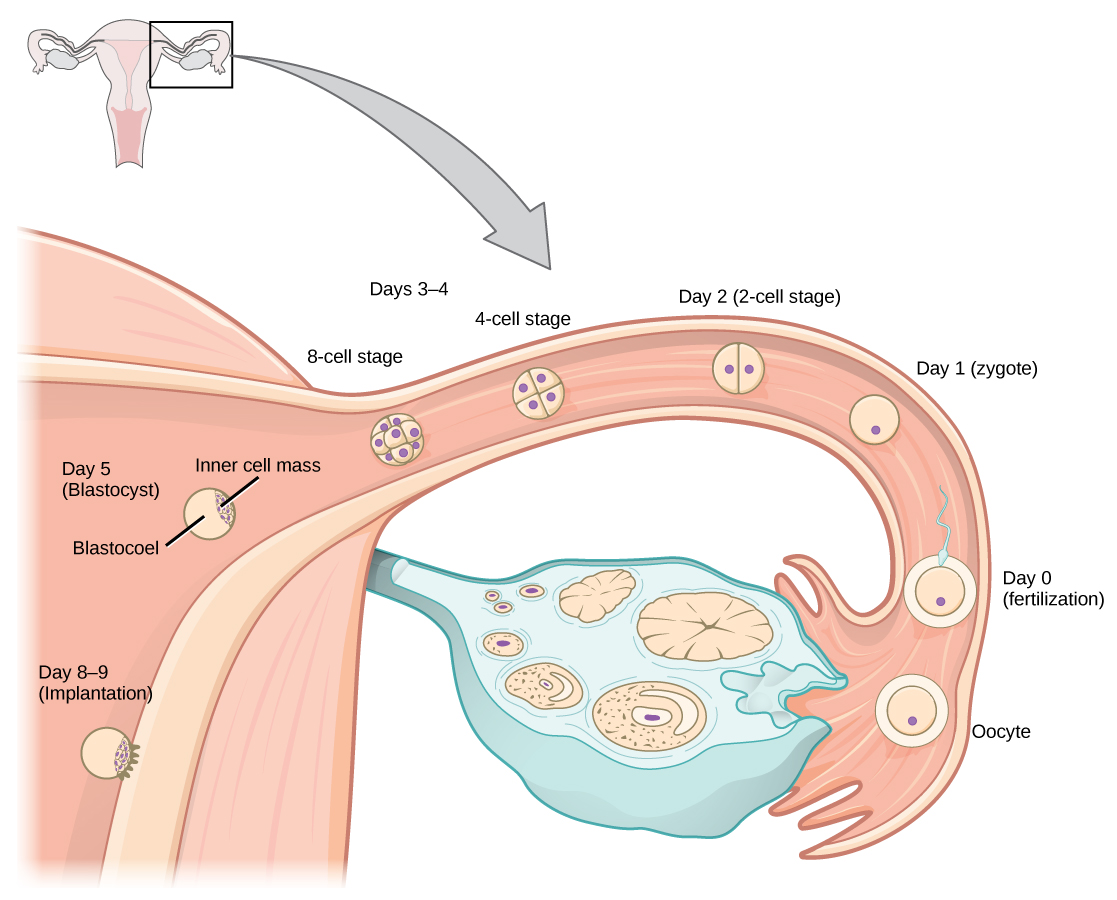
妊娠期分为三个相等的时期或三个月。 在头三个月的前两到四周内,营养和废物由子宫内膜通过扩散处理。 随着孕三个月的进展,胚胎的外层开始与子宫内膜合并,胎盘形成。 这个器官接管了胚胎和胎儿所需的营养和废物,母亲的血液将营养物质传递给胎盘并清除胎盘中的废物。 来自胎儿的化学物质,例如胆红素,由母亲的肝脏处理以消除。 母亲的一些免疫球蛋白将通过胎盘,为某些潜在的感染提供被动免疫力。
内部器官和身体结构在头三个月开始发育。 到五周后,肢芽、眼睛、心脏和肝脏已基本形成。 到八周时,胎儿一词适用,身体基本形成,如图所示\(\PageIndex{2}\)。 这个人的长度约为五厘米(两英寸),许多器官,例如肺和肝脏,尚未起作用。 在头三个月,接触任何毒素尤其危险,因为人体的所有器官和结构都处于初始发育阶段。 任何影响胎儿发育的东西都可能对胎儿的存活产生严重影响。
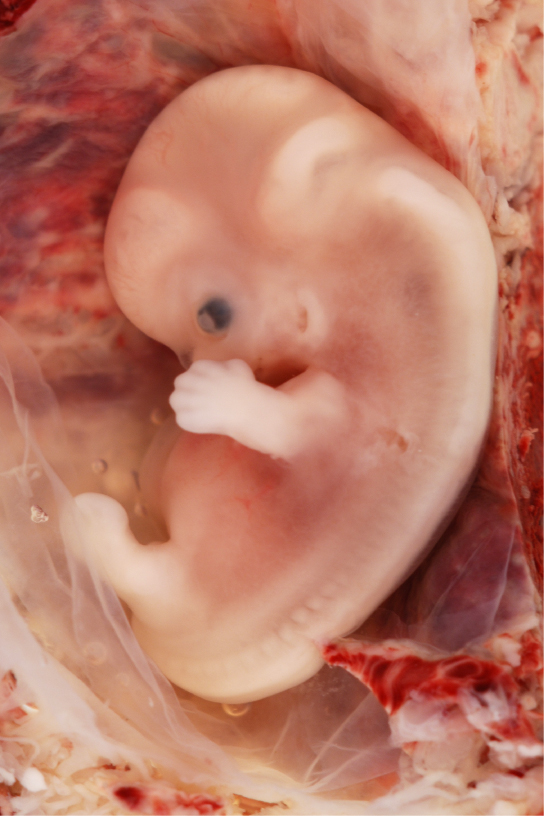
在妊娠中期,胎儿长到大约 30 厘米(12 英寸),如图所示\(\PageIndex{3}\)。 它变得活跃起来,妈妈通常会感觉到最初的动作。 所有器官和结构都在继续发展。 胎盘取代了营养和浪费的功能,并从黄体中产生雌激素和黄体酮,而黄体已经退化。 胎盘将在分娩期间继续发挥作用。
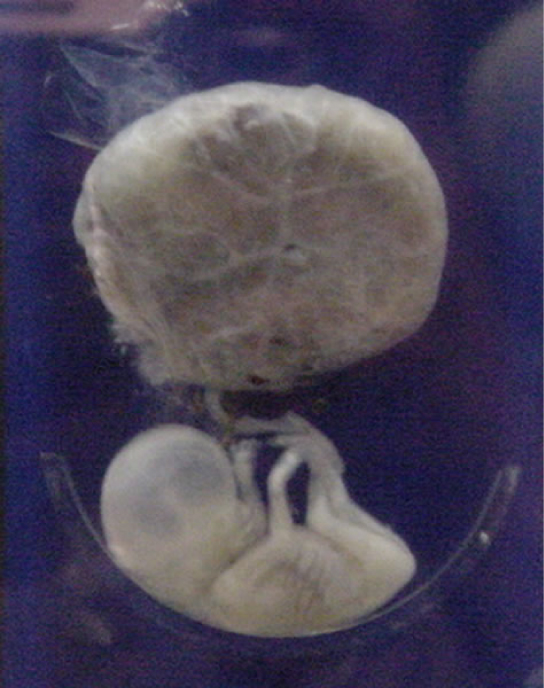
在妊娠晚期,胎儿长到 3 到 4 千克(6 ½ -8 ½ 磅),长约 50 厘米(19-20 英寸),如图所示\(\PageIndex{4}\)。 这是怀孕期间生长最快的时期。 器官发育持续到出生(有些系统,例如神经系统和肝脏,在出生后继续发育)。 在这三个月里,母亲会感到最不舒服。 由于胎儿对膀胱的压力,她可能会经常排尿。 还可能有肠道阻塞和循环系统问题,尤其是她的腿部。 由于胎儿在进入腹腔时对返回的静脉施加压力,她的腿部可能会形成血块。
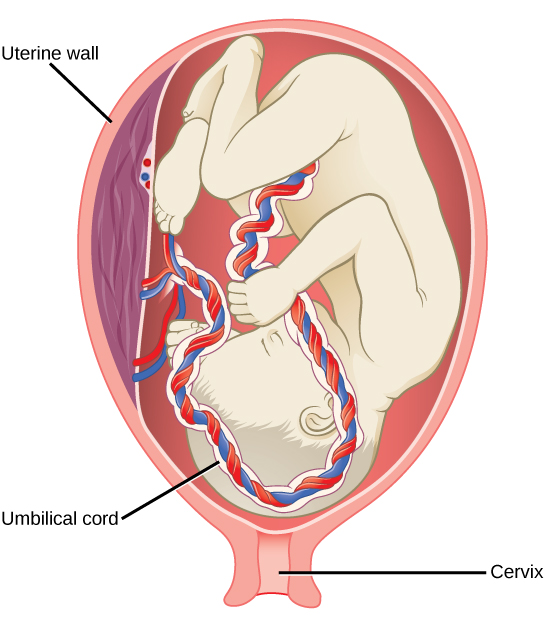
分娩和出生
分娩是在分娩(分娩)期间将胎儿和胎盘从子宫中排出的体力努力。 在妊娠晚期,雌激素会导致子宫壁上的受体发育并结合催产素激素。 此时,宝宝重新调整方向,朝前和朝下,头部后部或头冠与子宫颈接合(子宫开口)。 这会导致子宫颈伸展,神经冲动被发送到下丘脑,这表明催产素从垂体后叶释放。 催产素会导致子宫壁的平滑肌收缩。 同时,胎盘将前列腺素释放到子宫中,从而增加收缩。 子宫、下丘脑和垂体后叶之间发生正反馈中继,以确保催产素的充足供应。 随着越来越多的平滑肌细胞被招募,收缩的强度和力量会增加。
分娩分为三个阶段。 在第一阶段,子宫颈变薄并扩张。 这对于在出生时排出婴儿和胎盘是必要的。 子宫颈最终会扩张到大约 10 厘米。 在第二阶段,婴儿被排出子宫。 子宫收缩,母亲在压缩腹部肌肉以帮助分娩时推动。 最后阶段是婴儿出生后胎盘的通过,器官完全脱离子宫壁。 如果在进入第二阶段之前停止分娩,则可以服用合成催产素(称为皮托辛)来重新开始和维持分娩。
分娩和分娩的替代方法是通过称为剖腹产的手术对婴儿进行外科分娩。 这是一项重大的腹部手术,可能会给母亲带来术后并发症,但在某些情况下,这可能是安全分娩婴儿的唯一方法。
母亲的乳腺在妊娠晚期会发生变化,为哺乳和母乳喂养做准备。 当宝宝开始哺乳时,信号会发送到下丘脑,导致催乳素从垂体前叶释放。 催乳素使乳腺产生牛奶。 催产素也会被释放,促进牛奶的释放。 牛奶含有促进婴儿发育和成长的营养素以及保护儿童免受细菌和病毒感染的免疫球蛋白。
避孕和节育
预防怀孕属于避孕或节育的术语。 严格来说,避孕是指防止精子和卵子结合。 但是,这两个术语经常互换使用。
表\(\PageIndex{1}\):避孕方法
| 方法 | 示例 | 12 个月以上的典型使用失败率 |
|---|---|---|
| 屏障 | 男用避孕套、女用避孕套、海绵、宫颈帽、隔膜、杀精剂 | 15% 到 24% |
| 荷尔蒙 | 口服、贴片、阴道环 | 8% |
| 注射 | 3% | |
| 种植体 | 小于 1% | |
| 其他 | 自然计划生育 | 12 到 25% |
| 撤回 | 27% | |
| 消毒 | 小于 1% |
桌子\(\PageIndex{1}\) lists common methods of contraception. The failure rates listed are not the ideal rates that could be realized, but the typical rates that occur. A failure rate is the number of pregnancies resulting from the method’s use over a twelve-month period. Barrier methods, such as condoms, cervical caps, and diaphragms, block sperm from entering the uterus, preventing fertilization. Spermicides are chemicals that are placed in the vagina that kill sperm. Sponges, which are saturated with spermicides, are placed in the vagina at the cervical opening. Combinations of spermicidal chemicals and barrier methods achieve lower failure rates than do the methods when used separately.
Nearly a quarter of the couples using barrier methods, natural family planning, or withdrawal can expect a failure of the method. Natural family planning is based on the monitoring of the menstrual cycle and having intercourse only during times when the egg is not available. A woman’s body temperature may rise a degree Celsius at ovulation and the cervical mucus may increase in volume and become more pliable. These changes give a general indication of when intercourse is more or less likely to result in fertilization. Withdrawal involves the removal of the penis from the vagina during intercourse, before ejaculation occurs. This is a risky method with a high failure rate due to the possible presence of sperm in the bulbourethral gland’s secretion, which may enter the vagina prior to removing the penis.
Hormonal methods use synthetic progesterone (sometimes in combination with estrogen), to inhibit the hypothalamus from releasing FSH or LH, and thus prevent an egg from being available for fertilization. The method of administering the hormone affects failure rate. The most reliable method, with a failure rate of less than 1 percent, is the implantation of the hormone under the skin. The same rate can be achieved through the sterilization procedures of vasectomy in the man or of tubal ligation in the woman, or by using an intrauterine device (IUD). IUDs are inserted into the uterus and establish an inflammatory condition that prevents fertilized eggs from implanting into the uterine wall.
Compliance with the contraceptive method is a strong contributor to the success or failure rate of any particular method. The only method that is completely effective at preventing conception is abstinence. The choice of contraceptive method depends on the goals of the woman or couple. Tubal ligation and vasectomy are considered permanent prevention, while other methods are reversible and provide short-term contraception.
Termination of an existing pregnancy can be spontaneous or voluntary. Spontaneous termination is a miscarriage and usually occurs very early in the pregnancy, usually within the first few weeks. This occurs when the fetus cannot develop properly and the gestation is naturally terminated. Voluntary termination of a pregnancy is an abortion. Laws regulating abortion vary between states and tend to view fetal viability as the criteria for allowing or preventing the procedure.
Infertility
Infertility is the inability to conceive a child or carry a child to birth. About 75 percent of causes of infertility can be identified; these include diseases, such as sexually transmitted diseases that can cause scarring of the reproductive tubes in either men or women, or developmental problems frequently related to abnormal hormone levels in one of the individuals. Inadequate nutrition, especially starvation, can delay menstruation. Stress can also lead to infertility. Short-term stress can affect hormone levels, while long-term stress can delay puberty and cause less frequent menstrual cycles. Other factors that affect fertility include toxins (such as cadmium), tobacco smoking, marijuana use, gonadal injuries, and aging.
If infertility is identified, several assisted reproductive technologies (ART) are available to aid conception. A common type of ART is in vitro fertilization (IVF) where an egg and sperm are combined outside the body and then placed in the uterus. Eggs are obtained from the woman after extensive hormonal treatments that prepare mature eggs for fertilization and prepare the uterus for implantation of the fertilized egg. Sperm are obtained from the man and they are combined with the eggs and supported through several cell divisions to ensure viability of the zygotes. When the embryos have reached the eight-cell stage, one or more is implanted into the woman’s uterus. If fertilization is not accomplished by simple IVF, a procedure that injects the sperm into an egg can be used. This is called intracytoplasmic sperm injection (ICSI) and is shown in Figure \(\PageIndex{5}\). IVF procedures produce a surplus of fertilized eggs and embryos that can be frozen and stored for future use. The procedures can also result in multiple births.
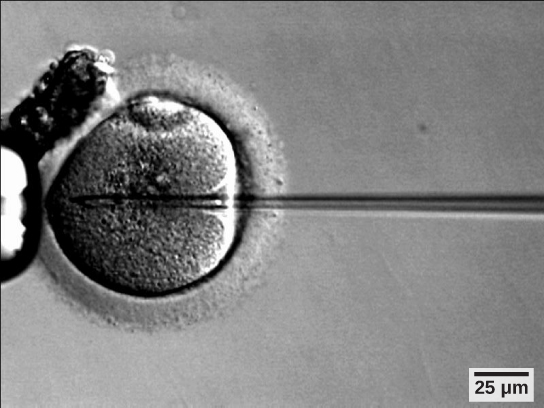
Summary
Human pregnancy begins with fertilization of an egg and proceeds through the three trimesters of gestation. The labor process has three stages (contractions, delivery of the fetus, expulsion of the placenta), each propelled by hormones. The first trimester lays down the basic structures of the body, including the limb buds, heart, eyes, and the liver. The second trimester continues the development of all of the organs and systems. The third trimester exhibits the greatest growth of the fetus and culminates in labor and delivery. Prevention of a pregnancy can be accomplished through a variety of methods including barriers, hormones, or other means. Assisted reproductive technologies may help individuals who have infertility problems.
Glossary
- contraception
- (also, birth control) various means used to prevent pregnancy
- gestation
- length of time for fetal development to birth
- human beta chorionic gonadotropin (β-HCG)
- hormone produced by the chorion of the zygote that helps to maintain the corpus luteum and elevated levels of progesterone
- infertility
- inability to conceive, carry, and deliver children
- morning sickness
- condition in the mother during the first trimester; includes feelings of nausea
- placenta
- organ that supports the diffusion of nutrients and waste between the mother’s and fetus’ blood



